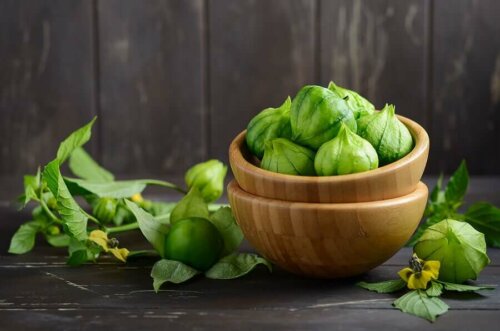7 Health Benefits of Eating Tomatillos


Written and verified by the doctor Mario Benedetti Arzuza
Also known as green tomatoes, fresadilla, milpa or miltomates, tomatillos are an outstanding ingredient in Mexican gastronomy. Nowadays they are part of many traditional recipes and often a complement to other ingredients such as corn, chili or beans.
Tomatillos are actually a fruit, although most people use them as a vegetable. Which is why they’re so easy to include in daily meals. This is a good thing because their interesting nutritional composition means they’re very healthy.
Today we’ll tell you other things you might not know about these fruits and how to include them in your diet for nourishment but also to add variety to your menu.
The Mexican tomatillos
Tomatillos (Physalis philadelphica) are the fruit of a plant that belongs to the Solanaceae family, which also includes other edible plants such as eggplant, potato, chili and, of course, tomato. However, it isn’t a variety of tomato, but a different fruit altogether.
The plant is native to Mexico, where people know it as tomate verde. Given the environmental conditions, it stops producing flowers and fruits as soon as the cold season arrives.
Now, during the warm season, the fruits grow wrapped in very thin leaves (that resemble paper). These protect the fruit from the cold temperatures. Hence, some also know them as “husk tomatoes.”
They’re round and measure about one to two inches (2.5 to five centimeters). When ripe, they have a smooth, somewhat sticky, yellowish-green surface.
The flavor of this fruit is sweet and sour and remind you of kiwi or lemon. They’re similar to unripe tomatoes but are quite different in spite of the color and shape.
Reasons to eat tomatillos

Nutrition professionals recommend complimenting a diet with tomatillos because they’re:
- High in antioxidants
- A source of fiber
- They provide vitamin C and niacin to the diet, in addition to other essential nutrients the body needs such as phosphorus, calcium, iron, potassium, and manganese
As you can see, tomatillos have several health properties due to their composition. Continue reading to find out what the most outstanding ones are.
1. Tomatillos improve vision
Given their contribution of antioxidants, vitamins, and beta-carotene, people believe tomatillos contribute to the maintenance of visual health.
The relationship between tomatillos being goo for vision derives from the presence of eye-positive nutrients in their composition. But, there are no studies evaluating the role of this particular food.
These components include lutein and zeaxanthin, two of the main substances in the macula of the retina. For this reason, they play an important role in the prevention of eye problems related to age-related degeneration.
2. They also improve digestion
Like the majority of vegetables, tomatillos provide a high level of dietetic fiber. This supports the functions of the digestive system and allows the body to better assimilate fats. Thus, it improves the intestinal tract and eliminates constipation, gasses, and abdominal distention.
Not to mention that fiber regulates the release of carbohydrates in the bloodstream. This helps to lower blood sugar levels. This is particularly useful for people with diabetes who need to control their glucose intake.
3. Tomatillos strengthen the immune system
As we mentioned above, tomatillos are high in vitamin C, a well known nutrient that helps stimulate the immune system. It accelerates red blood cell production, the body’s principal defense for protection against foreign agents and pathogens.
Also, it increases collagen secretion, which is in charge of keeping your skin, cells, and tissues that cover the organs and blood vessels in good shape. Because of that there is also improved metabolic function.
Find out how Tomatoes Can Help Lower High Blood Pressure
4. Tomatillos also increase energy

5. There’s room for tomatillos in a weight loss plan
Tomatillos have a high water and fiber content, which allows them to add volume to dishes without providing a high energy load.
For this reason, fruits and vegetables are two of the most important foods to help maintain body weight. In addition, this particular ingredient goes great in a wide variety of tasty yet light sauces.
6. Cardiac health
Potassium is one of the components of tomatillos. Furthermore, its characteristics are similar to those in sodium in regard to their impact on the cardiovascular system.
The body needs potassium for daily functioning. Specifically, it is responsible for:
- Assist in nerve function and muscle contraction
- Maintain a constant heart rate
- Counteract the negative effects of sodium on blood pressure
In addition, scientific evidence from recent decades shows that fruit and vegetable intake helps prevent the incidence of coronary heart disease, cardiovascular disease and stroke.
7. An ingredient to add variety to a healthy diet

Tomatillos are healthy ingredients with a great nutritional composition. Although they contain few nutrients in significant quantities, they’re an ideal supplement to meet daily vitamin and mineral needs.
They can, therefore, help improve the overall quality of your diet while providing a greater variety of foods.
Tips for choosing and storing tomatillos
Tomatillos are harvested between late summer and early fall. Unlike other fruits, they’re at their best when they’re green. As time goes by, they acquire red or purple tones but become more insipid.
To be sure to obtain quality fruits, choose those that are firm (not hard) and whose peels look fresh and intact. The peels may be slightly open but never broken.
At home they keep well for a couple of days at room temperature. If you need to keep them longer, place them in a paper or glass container in the refrigerator. Don’t remove the peel, and don’t keep them in a place where they’ll be tightly pressed against each other. They’ll last up to a week when stored properly.
Remove the peel when you’re ready to use them. You must then wash and dry them. They’ll be sticky but you can solve it by washing.
Ways to introduce tomatillos into your diet
Your tomatillos are ready for cooking once you’ve peeled and washed them. You can eat them whole so it isn’t necessary to remove the seeds or the core.
People use them in many different ways, either raw or cooked, and with all kinds of ingredients:
- As a sauce in traditional Mexican dishes like quesadillas, enchiladas, burritos, and others.
- Whole or chopped, they’re perfect for tostadas or veggie sandwiches.
- In salads. Note that it isn’t the same flavor and texture as red tomatoes, they’re different.
- In meat stews, stir-fries or curries.
- People in Mexico and Central America make sauces and these have a slightly sour flavor.
In general, few cases of allergy to tomatillos have been reported and their consumption is generally safe. Remove them from your diet and consult a physician if you experience discomfort or allergic reactions after eating them.
Try tomatillos as part of a varied diet
Introducing this fruit of Mexican origin isn’t only tasty but good for your organism. But, keep in mind that they won’t remedy any disease or health problem on their own.
Finally, the key to health and wellness is to maintain a well balanced wholesome diet. Never rely on a diet that asks you to eat a single food, beverage or preparation.
All cited sources were thoroughly reviewed by our team to ensure their quality, reliability, currency, and validity. The bibliography of this article was considered reliable and of academic or scientific accuracy.
- Aune D, Giovannucci E, et al. Fruit and vegetables and the risk of cardiovascular diseases, total cancer and all-cause mortality – a systematic review and dose-response meta-analysis of prospective studies. International Journal of Epidemiology. Junio 2017. 46 (3): 1029-1056.
- Caceres, A., Alvarez, A. V., Ovando, A. E., & Samayoa, B. E. (1991). Plants used in guatemala for the treatment of respiratory diseases. 1. Screening of 68 plants against gram-positive bacteria. Journal of Ethnopharmacology. https://doi.org/10.1016/0378-8741(91)90005-X.
- Demming-Adams B, Adams R. B. Eye nutriton in context: mechanisms, implementation and future directions. Nutrients. Julio 2013. 2483-2501.
- Food Data Central. Tomatillos raw. Abril 2019. U. S. Department of Agriculture.
- Maldonado, E., Pérez-Castorena, A. L., Garcés, C., & Martínez, M. (2011). Philadelphicalactones C and D and other cytotoxic compounds from Physalis philadelphica. Steroids. https://doi.org/10.1016/j.steroids.2011.03.018
- Mayo Clinic. Dietary fiber: essential for a healthy diet. Enero 2021.
- National Institutes of Health. Office of Dietary Supplements. Datos sobre la niacina. Febrero 2019. U. S. Department of Health and Human Services.
- National Institutes of Health. Office of Dietary Supplements. ¿Qué es la vitamina C? ¿Para qué sirve? Diciembre 2019. U. S. Department of Health and Human Services.
- Zhang, C. R., Khan, W., Bakht, J., & Nair, M. G. (2016). New antiinflammatory sucrose esters in the natural sticky coating of tomatillo (Physalis philadelphica), an important culinary fruit. Food Chemistry. https://doi.org/10.1016/j.foodchem.2015.10.007
This text is provided for informational purposes only and does not replace consultation with a professional. If in doubt, consult your specialist.








